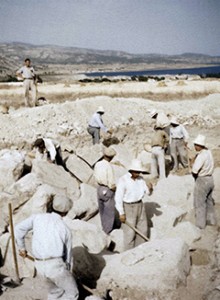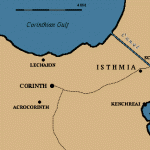To anyone sailing westward in the Saronic Gulf or traveling on the old Scironian Road from Athens to the Peloponnesus, the temple of Poseidon, seen with Acrocorinth in the distance, would have been a landmark.
The sanctuary itself lay immediately adjacent to the road on the first high ground after the coastal plain. Throughout all periods of its history the road continued close to the temple. In this location, easily accessible by land and sea, the shrine was a natural assembly place.
The Sanctuary of Poseidon on the Isthmus of Corinth became the major extramural shrine of the Corinthians, their most important religious foundation outside the city. It was one of four sanctuaries where Greeks from all parts of the Mediterranean came to compete in pan-Hellenic games.
Oscar Broneer discovered the temple of Poseidon in 1952 and until 1967 conducted systematic excavations of the central plateau that contained the temple, altar, surrounding buildings, and a Roman hero shrine.  He also cleared the theater, two caves used for dining, and two stadia for the Isthmian Games. In 1976, Elizabeth Gebhard succeeded Broneer as director of the University of Chicago Excavations at Isthmia. Efforts have been directed towards the final publication and conservation of objects recovered in Broneer’s excavations. In 1967, Paul A. Clement of University of California at Los Angeles undertook excavations in the Roman Bath and in the late antique fortress called the Hexamilion. After his death, he was succeeded in 1987 by Timothy Gregory of Ohio State University.
He also cleared the theater, two caves used for dining, and two stadia for the Isthmian Games. In 1976, Elizabeth Gebhard succeeded Broneer as director of the University of Chicago Excavations at Isthmia. Efforts have been directed towards the final publication and conservation of objects recovered in Broneer’s excavations. In 1967, Paul A. Clement of University of California at Los Angeles undertook excavations in the Roman Bath and in the late antique fortress called the Hexamilion. After his death, he was succeeded in 1987 by Timothy Gregory of Ohio State University.

